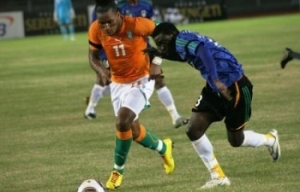This slideshow requires JavaScript.
Adjusting to life in Africa has been fascinating, if a little hectic, but fortunately there are a host of interesting places to get away from the construction boom underway in Malabo and Bata.
While most of the country’s expatriate employees spend much of the their free time at the exclusive surroundings of the city of Sipopo, playing golf or enjoying the best beach on the island, there are many other places to visit in this small but diverse country.
Most of Equatorial Guinea’s 28,051 square kilometres of territory remains untouched by the country’s breakneck development, which means that there are some wonderful spots to get away from it all and savour its impressive natural reserves.
On the island of Bioko itself, the trip to the towering volcano, Pico Basile, that serves as the imposing backdrop to the city provides a welcome change.
Reaching heights of 3.011 metres allows you to pass through all the different variants of rainforest on display in this part of the world. If you make it to the top the 4,040 metres-high Mount Cameroon on the mainland of neighbouring Cameroon can be seen looking out over the east of the island on a clear day.
If it is beaches you’re looking for then the sun-kissed islands of Corisco and Annobon serve up a perfect change of scenery and a dramatic shift in the rhythm of life.
Efforts to develop these two islands as tourist destinations for the local population and international visitors have heralded important investments in infrastructure of late.
In the larger of the two islands, Annobon, a new airport was inaugurated in October 2010.
A new port has also been constructed as well as hotel infrastructure to help open the island up to tourism. In total, the government has invested $400m in Annobon’s development.
The 600 m extension to the airport’s runway allows it to receive airplanes as large as the Airbus A320 and helped reduce its reliance on Equatorial Guinea’s Djibloho, the ship that has kept cargo and people moving between the country’s remote territories for more than a decade.
The Djibloho, has become something of an institution for the country’s inhabitants shuttling them to and from the different corners of the country on a daily basis.
Equatorial Guinea’s local airline Ceiba now offers services to the island, which is located 595 km south-west of the island of Bioko and the capital, Malabo.
Following a similar approach a runway and high-end beach villas are being built on Corisco in time for the Cup of Nations. While Annobon boasts a small local population of about 1,900, Corisco has had little development or human populations of note until work started on a tourism complex last year.
It was not always the case and long-forgotten aspects of the country’s rich history have been uncovered in the race to make Corisco habitable once more.
Those planning a return to the island encountered archaeological evidence of its importance to early European visitors earlier this month when they discovered the archaeological remains of an abandoned port and village constructed by some of the first Europeans to arrive in Africa.
What could be the largest and oldest necropolis in central Africa is believed to date back more than 2,000 years and point to the presence of predecessors of the Portuguese who discovered the island of Annobon in 1472.
Along with its neighbouring islets Elobey Grande, Elobey Chico, Corisco, has for decades, been fiercely disputed by Equatorial Guinea and its neighbour, Gabon, more for their importance in defining the limits of both countries’ offshore oil reserves than their idyllic beaches.
But a realisation of the finite nature of the country’s oil riches and the untapped potential of tourism in the country has placed greater emphasis on the latter in recent years. Beyond the country’s beaches there are also plans to build on the biodiversity of Equatorial Guinea’s different territories.
Some 60% of Equatorial Guinea is covered in largely pristine rainforest rich in flora and fauna. Efforts to preserve the thick rainforest from over-logging have been stepped up in the last few years including an initiative to designate 21% of the country’s territory as protected areas to preserve the biological, physical, technological, economic, cultural and social treasures they represent.
National Parks like the Monte Alen lowlands, a 200,000 hectare area on the mainland populated by gorillas and Pico Basile a 33,000 hectare park that covers most of the south of the island of Bioko as well as the Monte Mitra-Altos de Park, home to pygmy elephants are all preserved for environmentally-sensitive tourism.
Moving along the Rio Muni throughout the country’s mainland and following the path taken by Miguel Gutiérrez Garitano in his award-winning travel book, ‘La Aventura del Muni’ presents the more intrepid traveller with an intriguing insight into the continent’s rich cultural history and phenomenal natural treasures.
 o the dream continues. The Nzalang have navigated their way safely through the group stage thanks to euphoric victories over Senegal and Libya and a disappointing defeat to Zambia. The Elephants from the Ivory Coast, the strong favourites to win the tournament now wait for the boys in red on Saturday.
o the dream continues. The Nzalang have navigated their way safely through the group stage thanks to euphoric victories over Senegal and Libya and a disappointing defeat to Zambia. The Elephants from the Ivory Coast, the strong favourites to win the tournament now wait for the boys in red on Saturday.